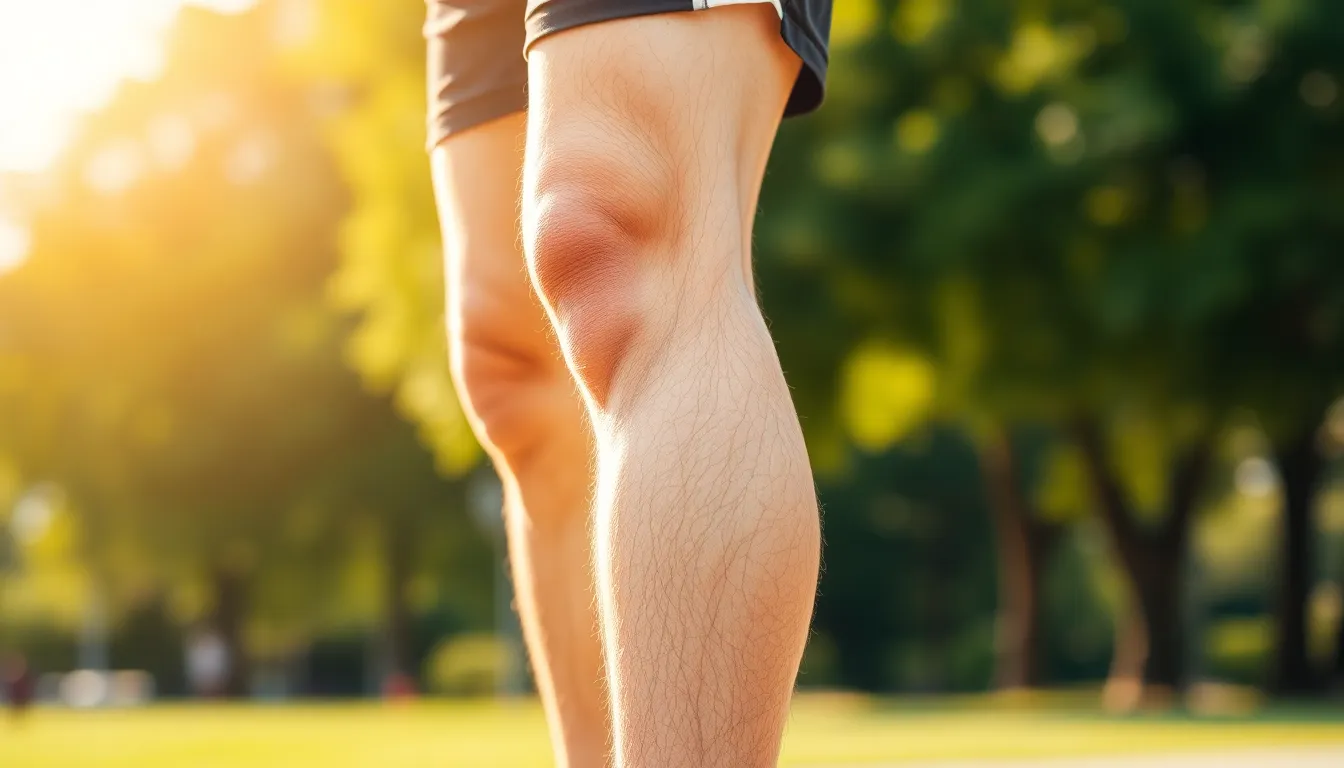Bulging veins in the legs can be a concerning sight, often leading to questions about underlying health issues. While many associate bulging veins with varicose veins, it’s essential to recognize that not all prominent veins indicate this common condition. Various factors, including genetics, lifestyle, and even certain medical conditions, can cause veins to bulge without being varicose.
Understanding the difference between bulging veins and varicose veins is crucial for anyone experiencing this issue. Knowing when to seek medical advice can help address potential health concerns early. This article explores the causes of bulging veins in the legs that aren’t varicose, shedding light on what they could mean for overall health and well-being.
Table of Contents
ToggleUnderstanding Bulging Veins in Legs Not Varicose
Bulging veins in the legs not related to varicose veins can result from various factors. Genetic predisposition plays a significant role. Individuals with a family history of venous issues often notice prominent veins.
- Age: Aging contributes as vein elasticity declines over time, leading to bulging.
- Physical Activity: High levels of physical activity can cause strain on the leg veins. Weightlifting or running increases blood flow and pressure within the veins, leading to visibility.
- Obesity: Excess weight puts added pressure on the veins, causing bulging.
- Hormonal Changes: Hormonal fluctuations during pregnancy or menopause may affect vein appearance.
- Medical Conditions: Conditions like venous insufficiency or deep vein thrombosis can contribute to bulging without varicosities.
These factors indicate that bulging veins often stem from non-varicose issues. Recognizing the distinction between bulging and varicose veins remains essential for proper assessment and potential treatment.
Causes of Bulging Veins in Legs

Bulging veins in the legs often arise from various underlying factors. Understanding these causes contributes to identifying potential health concerns.
Genetics and Family History
Genetics play a significant role in the development of bulging veins. Individuals with a family history of prominent veins are more likely to experience similar issues. Certain inherited conditions, such as connective tissue disorders, can affect vascular structure and function. For example, Ehlers-Danlos syndrome and Marfan syndrome may increase the likelihood of developing prominent veins. Recognizing these genetic links allows for better awareness and proactive management.
Lifestyle Factors
Lifestyle factors significantly influence the appearance of bulging veins. High levels of physical activity can lead to increased venous pressure, especially in athletes or individuals engaged in heavy exercise. Additionally, prolonged periods of standing or sitting may exacerbate this condition. Obesity serves as another contributing factor, as excess weight places additional strain on leg veins. Hormonal changes, particularly during pregnancy or menopause, can also impact venous health. Each of these factors underscores the necessity of adopting a healthy lifestyle to mitigate vein prominence.
Symptoms and Diagnosis
Bulging veins in the legs may present with symptoms that differ from those of varicose veins. Recognizing these signs is essential for accurate diagnosis and appropriate management.
Identifying Bulging Veins
Identifying bulging veins involves observing specific physical characteristics. Individuals may notice:
- Prominence: Veins appear noticeably raised and may feel firm to the touch.
- Coloration: The veins can appear dark blue or purple, contrasting the surrounding skin.
- Location: Bulging tends to occur primarily in the legs, particularly around the calves and thighs.
- Symptoms: Other sensations may include aching, throbbing, or a feeling of heaviness in the legs, especially after prolonged periods of standing or sitting.
Recognition of these symptoms aids in distinguishing bulging veins from other vein-related conditions.
Diagnostic Tests and Procedures
To evaluate bulging veins, healthcare providers use several diagnostic tests and procedures. Common assessments include:
- Physical Examination: The doctor inspects the legs and asks about symptoms and medical history.
- Ultrasound: A duplex ultrasound assesses blood flow and checks for underlying conditions like venous insufficiency or deep vein thrombosis.
- Venography: This specialized imaging technique provides a detailed view of the veins, confirming any abnormalities.
These diagnostic approaches ensure accurate identification of the condition, guiding appropriate treatment options.
Treatment Options
Various treatment options exist for managing bulging veins in the legs. These options range from home remedies and lifestyle adjustments to medical interventions.
Home Remedies and Lifestyle Changes
Home remedies and lifestyle changes significantly contribute to alleviating symptoms. Common strategies include:
- Compression stockings: Wearing compression stockings improves circulation and minimizes swelling. They come in various sizes and compression levels.
- Regular exercise: Engaging in low-impact exercises like walking, swimming, or cycling enhances blood flow and strengthens leg muscles.
- Weight management: Maintaining a healthy weight reduces pressure on the veins.
- Elevating legs: Elevating the legs during rest helps decrease swelling and promotes circulation.
Implementing these measures can lead to noticeable improvements in leg comfort.
Medical Treatments
Medical treatments address more severe cases of bulging veins. Common options include:
- Sclerotherapy: This minimally invasive procedure involves injecting a solution into the vein, causing it to collapse and fade over time.
- Laser therapy: Laser treatments target specific veins, using light energy to close them effectively.
- Endovenous laser treatment (EVLT): EVLT uses laser technology to seal off larger veins, promoting healthier blood flow.
- Vein stripping: This surgical option removes affected veins but is less common due to the availability of less invasive methods.
Consulting with healthcare professionals about these medical treatments is vital for selecting the appropriate approach.
Preventive Measures
Preventive measures can significantly reduce the risk of developing bulging veins in the legs. Adopting healthy habits supports vein health and enhances overall well-being.
Healthy Habits to Adopt
- Exercise Regularly: Engaging in low-impact activities like walking, cycling, or swimming promotes blood circulation. Regular exercise strengthens leg muscles, aiding venous return and reducing pressure in veins.
- Maintain a Healthy Weight: Keeping a healthy weight alleviates pressure on veins. Excess weight strains blood vessels, leading to increased prominence of veins.
- Stay Hydrated: Drinking adequate water supports proper blood circulation and keeps veins functioning optimally. Hydration helps maintain blood volume and reduces the risk of vein-related issues.
- Elevate Legs: Elevating legs during rest helps decrease swelling and enhances blood flow. Positioning legs at or above heart level encourages venous return.
- Wear Compression Stockings: Using compression stockings provides support to veins and improves circulation. These garments apply gentle pressure and can prevent vein bulging.
- Limit Prolonged Sitting or Standing: Taking breaks to move around during long periods of sitting or standing reduces venous pressure. Shifting positions frequently encourages circulation.
- Choose Proper Footwear: Selecting comfortable, supportive shoes can enhance mobility and reduce strain on leg veins. Avoiding high heels can help maintain healthy circulation.
- Incorporate Stretching: Regular stretching improves flexibility and circulation. Focus on calf and thigh stretches to promote healthy blood flow in the legs.
By implementing these habits, individuals can actively contribute to their vein health, minimizing the occurrence of bulging veins while promoting overall leg comfort.
Understanding bulging veins in the legs is crucial for distinguishing them from varicose veins. Recognizing the various causes and symptoms can empower individuals to take proactive steps toward their vein health. By adopting healthy lifestyle choices and seeking medical advice when necessary, they can effectively manage and potentially reduce the prominence of these veins. Awareness of the condition’s implications fosters better health outcomes and encourages individuals to prioritize their vascular well-being. Taking action today can lead to improved comfort and confidence tomorrow.


